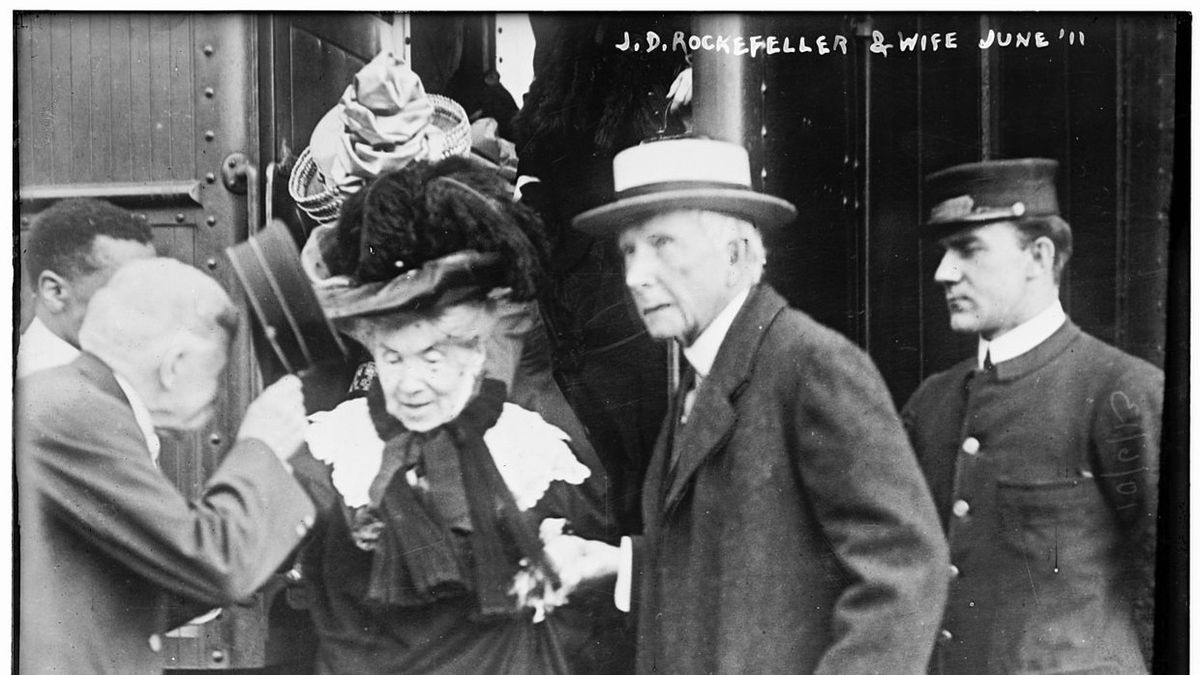JAKARTA - Talking about the figure of John Davison Rockefeller seems endless, especially for conspiracy theorists. His name is always referred to as the one who controls the world.
However, many know him as a hard worker. He amassed an abundant fortune from his business octopus. John D Rockefeller is known to be cruel when eyeing something, but on the other hand, the man who was born July 8, 1839, in Richford, New York was a lot of charity at the end of his age.
Quoted from History.com , Rockefeller was born from a simple family. His father was a traveling merchant. Little Rockefeller, helped raise money to support family life. She sells sweets, raises turkeys and also works part-time at a neighboring house.
In 1853, the Rockefeller family moved to the Cleveland, Ohio area. There, he received his education as an accountant at a private college. Entering 1855, Rockefeller got a job as a clerk at the company Hewitt & Tuttle which was engaged in shipping goods. Four years later, in 1859 to be precise, he quit his job and started a business with his co-workers.
They tried their luck as traders of straw, meat, grain and other goods. Profits at that time reached 450 thousand US dollars.
This success made them try out the booming oil industry at that time. Together with his partner, Rockefeller invested in the Cleveland refinery. Not only that, he also bought small companies to develop his oil company.
The well-established young Rockefeller married Laura Celestia Spelman in 1864. Laura was the son of a politician and construction entrepreneur. From this marriage they were blessed with five children, namely a son named John Davison Rockefeller Junior and four daughters, Edith Rockefeller McCormick, Elizabeth Rockefeller Strong, Alta Rockefeller Prentice and Alice Rockefeller who died at the age of 13 months.
Gary Allen wrote in his book, The Rockefeller Files , that in 1865 Rockefeller borrowed money from the bank to buy several companies owned by his business partners and take control of an oil refinery in Cleveland. In Rockefller's hands, the refinery was developed into the largest refinery at that time. The petroleum business at that time became the staple of the economy, and made Rockefeller even richer.
He widened his grip on the oil business. John D. Rockefeller with his brother William A. Rockefeller, and his business partners Henry Flagler, Jabez A. Bostwick, Samuel Andrews, and Stephen V. Harkness, founded the Standard Oil Company Of Ohio in 1870. John D. Rockefeller became the largest shareholder .
Thanks to the shrewdness of the lobby and its closeness to politicians, Standard Oil has acquired a monopoly in the oil industry. John is also active in buying refineries from middle-class companies and oil refineries of his business competitors. Standard Oil products are marketed worldwide.
Twelve years later, in 1882 the various Rockefeller companies that were purchased were merged into one company under the umbrella of the Standard Oil Trust. Of this large company, he controls 90 percent of the oil refineries and national oil pipelines.
When it comes to exploiting oil, Standard Oil does a number of things, from building its own barrels of oil to employing scientists to find out potential lands that contain petroleum.

The practice of monopoly and massive oil exploitation by Rockefeller was disturbed when Ida Tarbell exposed the cunning of the Standard Oil company in running its business. Ida Tarbell is a writer, lecturer, investigative journalist, and the daughter of a businessman who was a victim of Rockefeller. In his book, The History of the Standard Oil Company , published from 1902 to 1904, he tells how Rockefeller made his father bankrupt and his colleagues committed suicide.
In writing his book, Tarbell interviewed dozens of Standard Oil employees, visited the Standard Oil office, interviewed Standard Oil's representative, Henry Rogers, and visited a church that Rockefeller often visited.
Tarbell managed to collect 300 sources' testimonies, so detailed in the description, he was accused of spying for a rival company that would destroy Standard Oil.
Tarbell exposed the business practices of the Rockefeller company, from Standard Oil's role in supplying oil to soldiers in the civil war, employing government intelligence, obtaining special tariffs for transportation to transport oil, to threatening its competitors to join the Standard Oil monopoly game. If a company refuses, it is certain that the company will be destroyed.
In 1903, when Tarbell was uncovering the Standard Oil scandal, he saw Rockefeller sitting at a church service. "It's sad that anyone who sees John Rockefeller sitting in a church service will feel he is the saddest object in the world," wrote Tarbell.
Received harsh criticism from Ida Tarbell through his book, Rockefeller did not deny it. This was revealed by Elbert Hubbard who described Standard Oil's silence on the Tarbell attack which he wrote in a book entitled A Little Journey To The Home of John D. Rockefeller .
"Up to this point, or until recently, the Standard Oil company has refused to answer to its attackers. Its managers are so busy doing progressive things that they don't have time to wage rambling arguments. Standard Oil's silence could be either. interpreted as an admission of guilt. ' said Elbert Hubbard.
On September 29, 1916, all newspapers in the United States ran news about John D. Rockefeller who had crossed the 'magic barrier'. His status rose from a millionaire to become the first billionaire recorded in history. The trigger was the increase in the share price of the Standard Oil company.
"Rockefeller's 247,692 shares at that time were worth nearly $ 499 million. This fantastic value, combined with his holdings in a number of banks, railroad companies, as well as national, state and city bonds, made his fortune several billion dollars," he said. news as quoted from the Time news entitled Who Was Really the First American Billionaire . Since 1916, Rockefeller has been dubbed the first and only billionaire in the United States over a long period of time.
As Rockefeller's increased fortune and extraordinary success often made him a target for journalists and politicians. They see this king of oil as a symbol of greed. They also criticized the methods Rockefeller used in building his business empire.
"He (Rockefeller) was accused of destroying competition, getting rich at a discount off the railroad, bribing people to spy on competing companies, making secret deals, forcing rivals to join the Standard Oil Company under threat of being forced out of business, building great wealth above the rubble of others, and so on, "as quoted from the 1937 edition of The New York Times news archive
Rockefeller's business path, which is often considered cruel, even brutal, earned him another nickname, namely "the most hated person in America", as written in Rockefeller's biographical book Titan: The Life of John D. Rockefeller by Ron Chernow.
To erase that bad image, Chernow explained, Rockefeller gave most of his fortune to charity. He also always gave new coins to the little children who were nearby. Rockefeller generosity can be seen from the many institutions that work in the fields of social, education, religion, art, and health.
This transformation of Rockefeller into a philanthropist enhanced his family's image in society as a generous family. Rockefeller founded a charitable foundation in 1901 which he named The Rockefeller Institute for Medical Research. Engaged in the public health sector, he gave part of his income to develop the foundation to be useful in improving public health.
Sam Parr in his article entitled The Epic Rise of John D. Rockefeller which was published in the March 2016 edition of The Hustle called Rockefeller, "The cruelest, brazen, merciless, and gripping monopoly that has ever bound a country."
Standard Oil is notorious for selling kerosene to get local competitors out of the business. To destroy its competitors, Rockefeller would run tank cars and trains carrying its competitors' oil short of fuel. Then, it will buy all the barrels on the market so that its competitors have nowhere to store or ship their oil.
Rockefeller also purchases all the chemicals needed to purify the oil. In this way, Standard Oil's vast empire includes 20,000 domestic wells, 4,000 miles of pipeline, 5,000 tankers, and more than 100,000 employees.
After all, Rockefeller's influence in the oil business is still visible today. Even though Standard Oil was eventually forced to dissolve by the United States government, in fact Standard Oil's subsidiaries are still standing tall today, such as Exxon, Conoco Phillips and Chevron.
John David Rockefeller, founder of Standard Oil is the richest man who ever lived. His wealth is recorded not only in American history, but in world history.
In 1937 John Davison Rockefeller suddenly died at the age of 98. He was found dead alone without his family accompanied.
The Albany Evening News newspaper, May 24, 1937, covered John Rockefeller's death as " Aged Philanthropist Dies Relatively Poor Man in 98th Year."
The English, Chinese, Japanese, Arabic, and French versions are automatically generated by the AI. So there may still be inaccuracies in translating, please always see Indonesian as our main language. (system supported by DigitalSiber.id)









